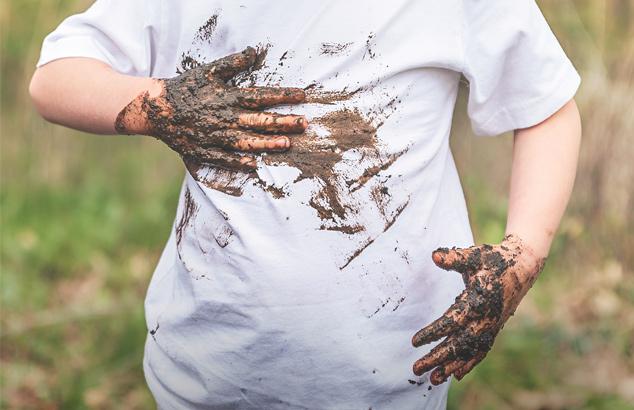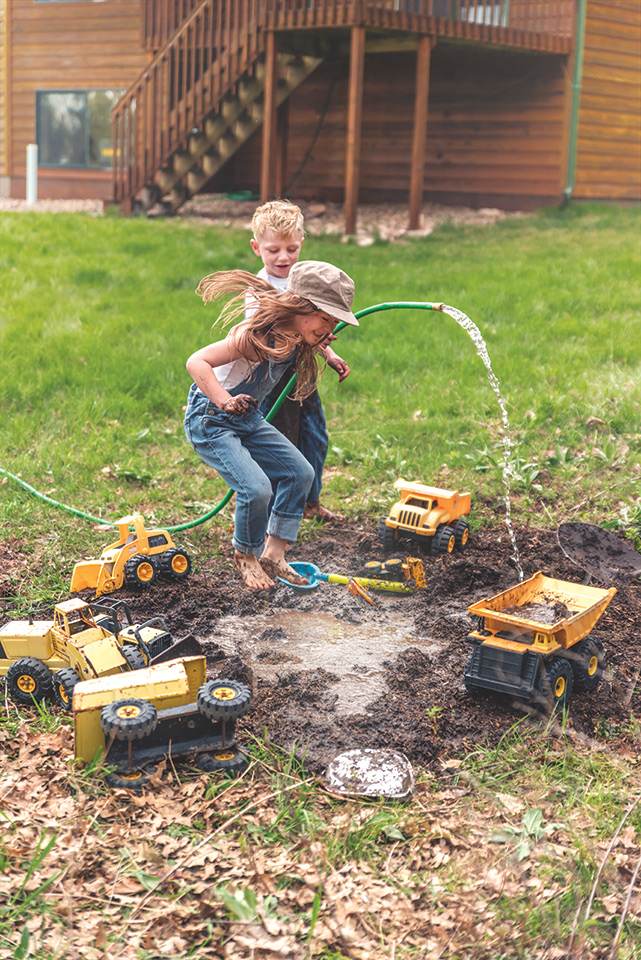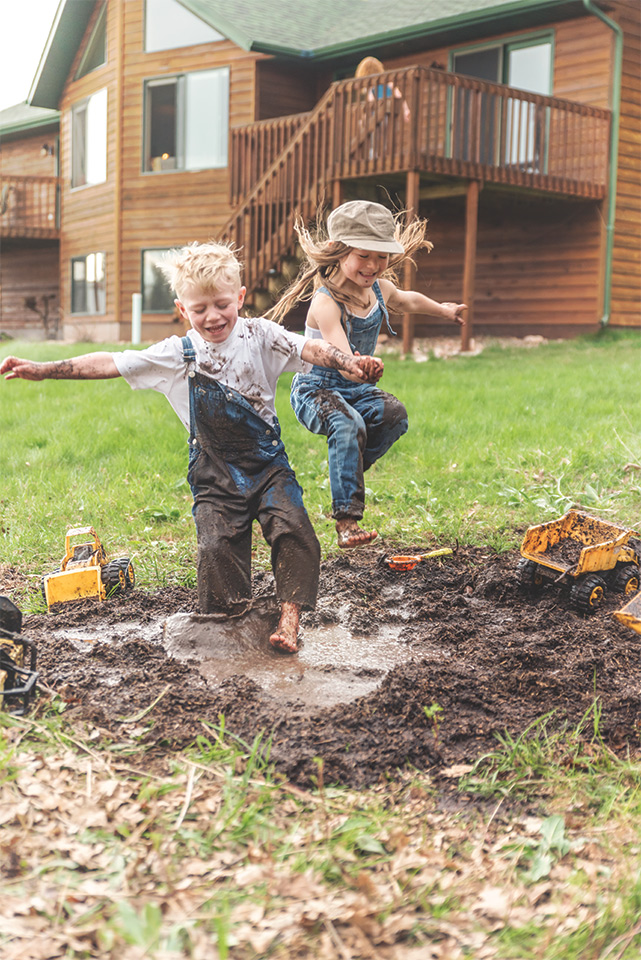Kids love mud—it’s just a fact. Whether it’s the batter for fresh muffins, or the building material for mini dams, or perhaps just the satisfying squish between toes during a hike through a streambed, a young child seems drawn to the stuff as if by design.
Parents, on the other hand, may be less enthusiastic. Mud is, well…dirty. But there are still plenty of good reasons to let your kids play in mud. The National Wildlife Federation’s report The Dirt on Dirt: How Getting Dirty Outdoors Benefits Kids states, “The things small children want to do outside, like building mud castles, splashing around in puddles and rolling down hills…may, in fact, be a grubby little prescription for health and happiness.” Here’s more on the benefits of getting muddy.
Physical health. There is a growing body of evidence suggesting that early contact with some of the infectious microbes found in soil can result in a lower risk of heart disease later in life. Other studies have linked the over-use of sanitizers and sterilizing products to a higher incidence of allergies and autoimmune disorders. In the BuckMD Blog of Ohio State University, Dr. Victoria Rentel, MD cites a study in which the digestive tracts of indoor pigs were compared to those of outdoor pigs, and concludes, “There is…a growing, stinking, microbial-filled gooey heap of evidence that human interaction with bacteria is good.” In addition, many experts have noted the connection between a sedentary lifestyle and an unhealthy body. “When children (or adults!) spend too much time in front of a screen it limits the time they spend in physical activity,” explains Dr. Margaret Kuehler, MD, FAAP – a Pediatrician at Black Hills Pediatrics and Neonatology. “We also limit physical activity by spending more time in cars, seated at desks, and even asking kids to just “sit quietly” while we attend to errands. Recent studies show that the more time we spend in sedentary activity the higher the risk of developing obesity, type 2 diabetes mellitus, and even some types of cancers.”
Mental health. Look at a child’s face as she splashes in a muddy puddle, and you know she just feels good. Studies suggest this feeling of well-being may result, at least in part, from a child’s contact with the soil. A bacterium found in dirt (M. vaccae) has actually been linked to increased levels of serotonin, a compound in the brain related to feelings of happiness. As early childhood educator Bev Bos states in her book Before the Basics, “Children were not born to wear shoes. In our concern for hygiene and safety, we develop amnesia. Give children a break! Remember how good mud feels between the toes?” Physical play outdoors can also result in gains in independence and creativity. Becky Almeida, OTD, OTR/L at Black Hills Pediatric Therapy sees the transformation, not only through her profession, but through the camps they offer at the TimberNook Black Hills. “Play in natural spaces is much more creative because of the lack of structure. Oftentimes, children will look to adults for how to play. But, when they use that natural space, they don’t have the initiative of something to build off – like sliding down a slide, or swinging on a swing.” Chad Tussing, Director at the Outdoor Campus-West, agrees. “One of the best reasons: there aren’t any instructions! Kids (and adults) get to use their imagination to create their tools, toys, and shelters. A fallen branch instantly becomes a horse or sword or gun or hiking stick,” sad Chad.
Educational benefits. Young children learn by engaging in hands-on activities with real objects. Put simply, children learn by getting their hands dirty. Unstructured free play (that is, play initiated by the child and not led by an adult) has been shown to promote cognitive growth and to positively influence social interactions. Yet today, a child’s schedule is often packed with hours of directed activities in school, sports, or aftercare programs. Free time is spent in front of one screen or another. There seems to be less and less time to “just muck about.” During unstructured play children plan, make decisions, and see the results.
Connection with nature. Many experts agree that our children are quickly losing any connection to the natural world. Becky talks about how the children participating in their camps learn to make use of the immediate natural wonders. “We encourage an awareness to the space around them by taking a step back as adults and taking them into the woods–allowing them to explore in a supervised environment. As they learn to play on their own, they take those skills home and are able to apply them to playing in their own backyard.”
Today our children have more on their plates (often literally) than ever before. We tend to lead over-scheduled, yet sedentary lives. The CDC reports that obesity rates among our youth have tripled in the last 30 years. Pediatric use of antidepressants and medications for ADHD has skyrocketed in the last decade. But it seems that playing in the dirt and mud, whether in the backyard or hiking along a creek bed might be the perfect antidote. Dr. Kuehler says, “Parents often feel better about using T.V and other screens for “educational” purposes but it is important to remember that young children often learn more from hands-on education – like writing letters with their finger in the dirt. The American Academy of Pediatrics has guidelines in regards to screen time and media use but it is important to remember that limiting screen time is only half of the equation. We often forgot to encourage active play!”
Many parents can agree that running around in the fresh air – rain or shine – helps improve their children’s behavior and overall attitude. Couldn’t your kids use a little mud medicine?





